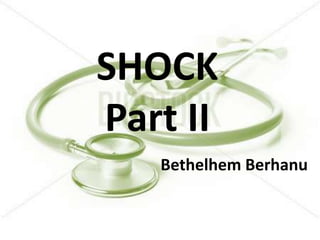
Shock : hypovolemic, septic and neurogenic
- 2. Classification of Shock Shock Hypovolaemic Septic Cardiogenic Distributive Anaphylactic Neurogenic
- 3. Hypovolemic Shock • most common • reduced circulating volume Hemorrhagic shock External or Internal Non Hemorragic hypovolemic shock Vomiting Diuresis Diarrhoea Burns
- 4. Pathophysiology of Hypovolemic shock Hypovolemia Multiorgan failure ↓Venous Return ↓Preload CO = SV x HR ↓Cardiac output BP = CO x TPR Hypotension Perfusion failure & Tissue hypoxia Organ dysfunction
- 5. Bodily responses Physiologic responsessympathetic activity – tachycardia and SVR Hyperventilation collapse of venous capacitance vessels stress hormones Attempt to replace intravascular volume loss The body will prioritize – Brain and heart Severity ~ magnitude and the rate of fluid loss
- 6. “TENNIS STAGING” 15,15-30,30-40,40 American College of Surgeons, 1989 Postural Drop
- 7. Clinical Manifestations • • • • • • • • Anxiety - lethargy Tachypnea Tachycardia – weak, thready pulse Normal → Orthostatic drop → Hypotension Delayed Capillary refill Cool clammy skin Oliguria Thirst
- 8. Mild (<20% Blood Volume) Moderate (20–40% Blood Volume) Severe (>40% Blood Volume) Cool extremities Same, plus: Same, plus: Increased capillary refill time Tachycardia Hemodynamic instability Tachypnea Marked tachycardia Oliguria Hypotension Postural changes Mental status deterioration (coma) Diaphoresis Collapsed veins Anxiety
- 9. Treatment principles: Hypovolemic Shock • control ongoing loss • rapid reexpansion of the circulating intravascular blood volume • GOAL: restore blood volume and improve tissue perfusion and oxygenation
- 10. Control bleeding • • • • • Direct pressure on the site of wound, Gauze Elevation Pressure points Tourniquets Surgical Methods • • • • Artery forceps (Spencer Well’s forceps) Ligation Cauterisation Splenectomy – splenic rupture, Hysterectomy for post partum bleeding
- 11. Treatment contd. • ABC … – Supplemental Oxygen – Endotracheal intubation • Secure a large bore IV line for fluid resuscitation – Median cubital vein, saphenous vein and sometimes the internal jugular and subclavian veins – In pediatric patient - intraosseus line
- 12. Re-expansion of Intravascular volume Fluid Therapy Crystalloid solutions – 0.9% saline Ringer Lactate Colloid solutions – 5% albumin, gelatins, hetastarch 20 ml/kg in 5 – 15 minutes – repeat upto 60 ml/kg Blood transfusion – 1 unit of blood in 20 minutes >40% of blood loss (class IV) If the patient is anemic ( Hg < 8g/dl) We may need to supplement fresh frozen plasma and platelates
- 13. Treatment contd. • Improved perfusion : Warmth Strong pulses Better capillary refill improved mental status Lower HR BP – ideally 90+(agex2) higher Urine output.
- 15. Septic Shock Sepsis • Septicemia - Presence of microbes or their toxins Sepsis and organ in blood dysfunction, hypoperfusion, Severe Sepsis or hypotension • Sepsis – Systemic inflammatory response syndrome (SIRS) that has a proven or suspected microbial etiology Septic Sepsis-induced hypotension • Severe sepsis – Hypoperfusion with signs of organ shock dysfunction – Lactic acidosis, oliguria etc. • Septic shock - Sepsis + hypotension (ABP<90 mmHg systolic, or MODS 40 mmHg less than patient's normal BP) for at least 1 hr despite adequate fluid resuscitation; Death
- 16. Septic, contd. • Importance?? – The most common of the distributive types, – The leading cause of Deaths in ICU in the US. – Increasing in occurrence • Increased life support for high risk patients • Increase in invasive procedures • Growing number of the immunocompromised – HIV – Chemotherapy
- 17. Septic, contd. • PREDISPOSING FACTORS - examples –Extended hospitalization –Advanced age –Debilitating illness –Immunodeficiency disorder –Disseminated malignancy
- 18. Septic, contd. • Focus of infection – Pneumonia, UTI, Meningitis, skin and soft tissue infections, GI infections, etc. • Gram –ve bacteria (70%) – LPS – Lipid A • Peptidoglycan & lipoteichoic acid of gram +ves • Polysaccharide surface of Candida
- 19. Septic, contd. MONOCYTE, MACROPHAGES NEUTROPHILS CD 14 Bacteria LPS LPS TNF-A IL-1 ENDOTHELIAL CELL LBP LPS soluble CD 14 LBP LPS Cellular chemotaxis Endotherlial injury Activation of coagulation cascade
- 21. Septic, contd. • The syndrome of septic shock – Systemic vasodilation (hypotension) – Diminished myocardial contractility – Widespread endothelial injury and activation, causing systemic leukocyte adhesion and pulmonary alveolar capillary damage (ARDS) – Activation of the coagulation system, culminating in DIC
- 22. Septic Shock Hemodynamics Warm (hyperdynamic) shock hypotensive tachycardia tachypnea bounding pulse warm, well perfused extremities skin flushed, moist Cold (hypodynamic) shock hypotensive tachycardia tachypnea narrow, thready pulse cold, poorly perfused extremities skin pale, dry
- 23. Principles of treatment: Septic shock • Ventilatory support • IV fluids – crystalloids or colloids - Fill the tank • Vasoactive agents – Norepinephrine, Dopamine etc. • Draw blood for culture – before Antibiotics • Remove septic focus – Resect a gangrenous bowel, Drain an abscess • Early empirical antibiotic therapy
- 24. Neurogenic Shock • Cause – high spinal cord injury, spinal anaesthesia • Pathophysiology - Interruption of sympathetic vasomotor input • extremities are warm • Rx – IV fluids • norepinephrine or a pure -adrenergic agent (phenylephrine)
- 26. Hypovolemic shock • History – • Trauma • tearing type of chest pain • hematemesis, melena, severe diarrhea • P/E – Obvious bleeding • Cool clammy skin • sweating • Narrow pulse pressure • Delayed capillary refill • Anxious, confused
- 27. Cardiogenic shock • History - chest pain, shortness of breath, diaphoresis, syncope etc. • Symptoms of Hypoperfusion plus • Raised JVP • gallop • Rales – Basal creptations • Beck’s triad
- 28. Septic shock • History – Sx of underlying infection • P/E – Evidences of Infection – Warm extermities – Bounding pulse – Wide pulse pressure – Brisk capillary refill – Obtunded
- 31. References • Harrison’s principles of internal medicine18th edition • ACS surgery: principles & practice • Mannipal manual of surgery • Robbin’s basic pathology • Shwartz principles of surgery • Davidson’s principles and practice of medicine • World Wide Web
- 32. QUESTION
Notas do Editor
- E.G internal bleeding – after rupture of aortic aneurysm or from ectopic pregnancy
